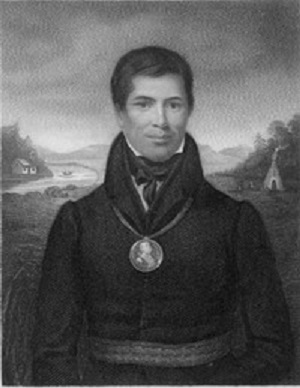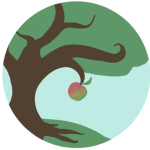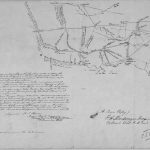
Grade 7 History, UNIT 2 – 1800-1850: CONFLICT AND CHANGE
Unit 2 Lesson 2 by Melissa De Caires
Image of Peter Jones from Dictionary of Canadian Biography, http://www.biographi.ca/en/bio/jones_peter_8E.html
LESSON TITLE: Immigration: Growth and Displacement of Settlement in Upper & Lower Canada and How It Affected First Nations Communities
TIME: 80 minutes (2 class periods)
EXPECTATIONS:
- Explain the reasons for and impact of immigration on First Nations communities in Canada in the early 1800s
- Read, interpret and analyze data from maps of the past
- Expand on vocabulary learned from introductory lesson (settlement, immigration, displacement)
Curriculum (Specific Expectations):
B1.2 analyse some of the challenges facing individuals and/or groups in Canada between 1800 and 1850
B1.3 analyse the displacement experienced by various groups who were living in or who came to Canada between 1800 and 1850 and how some of these groups dealt with their displacement
B2.3 analyse and construct maps as part of their investigations into some significant events, developments, and/or issues that affected Canada and/or Canadians during this period, with a focus on exploring their spatial boundaries
ASSESSMENT:
- Assessment for learning: Think, Pair, Share during the Minds On activity to determine students’ readiness to learn new knowledge and skills, as well as learning about students’ interests
- Assessment as learning: Jigsaw activity during the main portion of the lesson, to build on students’ knowledge with modelling and guidance from the teacher
- Assessment of learning: 3-2-1 strategy to assess students’ learning at the end of the period and inform further instruction
PLANNING NOTES:
- Answers to the Jigsaw activity can be found using Nelson History 7 textbook or online
- Teachers will need access to a screen/projector to do mapping activity as a class, or have students do it individually on computers as you speak
- Teacher will also need to explore and become familiar with the interactive map on the website
PRIOR KNOWLEDGE REQUIRED (of STUDENTS):
- Students will need to have prior knowledge in reading and deconstructing maps
- They will need to have learned about the War of 1812 and how it has affected settlement in Canada during this period
ACCOMODATIONS/ MODIFICATIONS:
- Have a word wall available in the classroom for students struggling with the vocabulary
- Ensure students are grouped accordingly
- Increase/decrease the amount of key points needed depending on students’ abilities and strengths
- Provide an alternative to writing down answers, such as orally communicating their thoughts, or illustrating
RESOURCES:
- Jigsaw Worksheet (appendix 1)
- Interactive maps links
‘Native Population, Economies and Movement, ca 1820’
‘Population Distribution, ca 1825’
Nelson History 7 textbook
TEACHING / LEARNING TASKS DURATION (APPROX):
Minds On (15 minutes)
Students will be asked to close their eyes an imagine their favourite place or a place they feel most comfortable in. Have them create a vivid image of this place in their minds, thinking about how it makes them feel, what sound they hear, the smells, and what kinds of things they see or taste. Next, tell students to imagine someone suddenly taking it away, telling them to leave it all behind. Ask students: How does this make you feel? And have a Think, Pair, Share of their responses.
If time permits, have the students’ perspective on the situation change, as they are now the ones intruding on someone else’s space, taking something valuable from someone else. Does this change your initial reaction/feelings? Are you, or could you be, justified in taking what does not initially belong to you?
Action
Jigsaw activity (30 minutes)
Students will be grouped and numbered 1 to 3 within their home groups. Once they are given their questions, they will regroup with students that share the same number (expert group) and identify 2-3 key points in response to each of the questions assigned to them. After each expert group has identified their points, students will go back to their home groups to share and discuss their results. Answers are to be recorded on each section of the Jigsaw worksheet based on the information collected in their expert groups and provided from their home groups. The questions are as follows:
Group 1
- What factors influenced people’s decision to move from their homelands to a new country/Canada in 1815?
- What were some of the travelling conditions people had to endure during this period?
Group 2
- How did immigration to Canada change the settlements already established prior to their arrival?
- What is the cholera epidemic and how did it affect the people living in Canada at the time, specifically the First Nations communities?
Group 3
- What factors impacted the First Nations relationship with their land?
- Name one First Nations community impacted by immigration and settlement from Britain? What were some of the problems they were facing?
- Who is Peter Jones and why is he significant?
As a class, discuss students’ results.
‘Mapping the Movement’ activity (25 minutes)
Beginning with a brief review on how to read a map, students will build on their prior knowledge of reading, analysing and interpreting maps from Geography class to complete this activity.
Together as a class, be looking at the map of ‘Native Population, Economies and Movement, ca 1820’ to analyze the information found on this map. Focus on the features of the map (i.e. title, symbols, etc.), and what information is provided.
Questions to consider:
- Who might be interested in the data presented and collected from this map? Why?
- What do we understand from this map in terms of immigration and settlement on First Nations communities?
If time permits, also look at map of ‘Population Distribution, ca 1825’ to study the settlement and patterns of European settlement of the time, and compare with initial map.
– What observations and conclusions can be made from these two maps?
Consolidation (10 minutes)
Use the 3-2-1 strategy to check students’ learning of this lesson.
Organized as follows:
- 3 effects of immigration on First Nations communities and people
- 2 reasons for British immigration to Canada
- 1 question/idea you are still wondering about OR an idea/fact you found most interesting
HOMEWORK:
Students will answer the following questions with some additional research:
- How has the settlement patterns of First Nations communities and European settlement changed today?
- What stayed the same, if anything?
They will find 2-3 points from their map comparison and analysis.
They must include an image/s of the maps they are comparing with its cited sources.
Appendix 1 JIGSAW ACTIVITY: THE IMPACTS OF IMMIGRATION ON COMMUNITIES
For each of the questions below, identify 2-3 key points in the right-hand column.
| Questions | Key Points |
| What factors influenced people’s decision to move from their homelands to a new country/Canada in 1815? | |
| What were some of the travelling conditions people had to endure during this period? | |
| How did immigration to Canada change the settlements already established prior to their arrival? | |
| What is the cholera epidemic and how did it affect the people living in Canada at the time, specifically the First Nations communities? | |
| What factors impacted the First Nations relationship with their land? | |
| Name one First Nations community impacted by immigration and settlement from Britain? What were some of the problems they were facing? | |
| Who is Peter Jones and why is he significant? |

